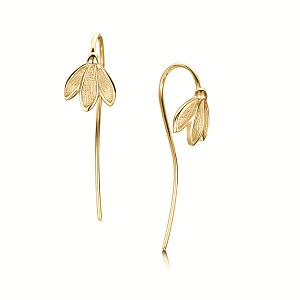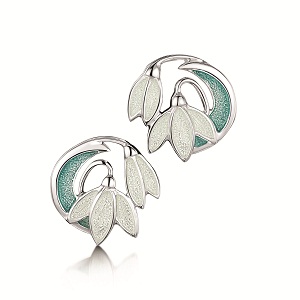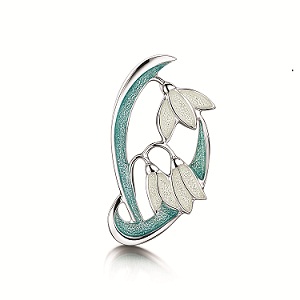About Celtic
History of the Celts
The Celtic people or Gauls as the Romans called them originally came from Eastern Europe. They used the river Danube as their motorway for travel. Using this river they spread into Germany, Austria, Switzerland, regions of France, Scotland, Ireland and Russia in the East. By the time the Celts existence was recorded in the 4th century by the Greeks, there numbers were so large that they were named one of the four great barbarian peoples of the world. The Celts dominated a large area with each tribe having their own identities. They did however, share similarities in religion, language and lifestyle. The Greeks described the Gauls/Celts as tall people with pasty white skin and blonde hair usually scraped back from their foreheads. They dyed their bodies with a substance called woad and drew animal forms and swirly patterns on their skin. The woad turned a bluish colour and was thought to make the Celts look fierce in battle. They also went into battle in the nude to show more of their scary skin to good effect. Patterns decorated clothing and everyday objects as well. The Celts lived in large circular houses with wicker walls and thatched roofs. They ate and slept on the floor using wild animal pelts to keep them warm. The fire was in the centre part of their home so there was room for everyone to gather round. Many artefacts of the iron age have been found. These include handmade decorated pottery from Somerset and bronze brooches to hold their cloaks in place. The most exciting find was the Aylesford bucket, a wooden bucket with a handle and bronze banding. The handle, edges and the feet have beautiful engraved patterns of Celtic art on them.
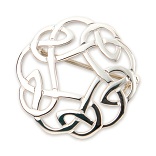 Click to visit Celtic Brooches | 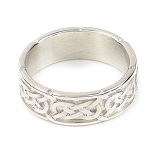 Click to visit Celtic Wedding Bands | 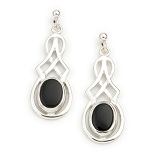 Click to visit Celtic Earrings |
Inspiration of Celtic Jewellery
You have read that the Celts painted themselves with wood dye and that they were fond of their animal pictures and symbols. Most of the examples of Celtic artwork seen today come from stone carvings,some as old as 3000BC or from burial sites where often jewelry and pots are all that is left. Celtic artwork is made up of many different interlinked patterns. Much of it is copied today in jewelry in gold and silver. Scotland has many inspirational sites but probably the most inspiring is Skara Brae in the Orkney Islands, in the far North East coast of Scotland. Skara Brae was a Celtic settlement and many patterns have been taken from the objects found there. Rings, pendants, earrings and brooches have all been inspired by these ancient designs. Torque bangles have been found dating back to the stone age made with precious gold alloy. The most common form of motif is the single spiral expansion, probably the meaning of prosperity. The Irish Celts used it as a symbol of their sun, loosely wound meant a big sun ";summer" and tightly wound was the symbol for "winter". A double spiral in the form of an S shape meant day and night are the same time. Three piece spirals were the starting signs of Christianity and were used by the early monks, probably associating the 3 trinities: father, son & holy ghost. They look similar to the Isle of Man symbol today. Fierce animals were used which looked similar to wolves with pointed muzzles and long tails. The animal patterns are called Zoomorphs and are very common, mixed with interlacing knots. The interlacing knots are meant to mean everlasting as there is no beginning and no end and are a popular pattern in wedding rings for obvious reasons. Celtic wedding rings are available in gold and silver on our web pages. Please feel free to browse. Borders are also popular and come from the need of monks to attractively frame their handiwork and finish it off. Borders can take the shape of pleating or intricate knots. The Greek key pattern was thought to be inspired by the Celtic peoples art, and didn't come from the Greeks alone. It's amazing to think that after all the thousands of years that have passed, these patterns are still popular and have been fashioned into a wide selection of gold and silver jewelry.
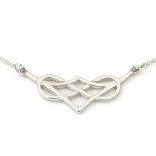 Click for Celtic Necklets | 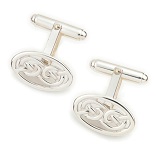 Click for Celtic Cufflinks | 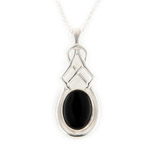 Click for Celtic Pendants |
Celtic Symbols
Much of the Celtic art is depicted with animals as the subject. The Celts were in awe of animals; birds in particular were used on jewellery, cookware and murals on walls. The Celts seemed to think that by painting a certain animal on their belongings, they would miraculously be bestowed with its characteristics; i.e. they would have the bravery and cunning of a wolf and look fierce in battle like a wolf, a hawk would give them good eye sight, mystical foresight sometimes which comes from Celts envying birds being able to fly. The Celts lovingly recreated animal symbols on their shields, a practice, which strengthened in medieval times and became the forerunner of Heraldry. Clans were recognised by their crests.
The earliest animal used by the Celts was the snake and has its origins in the Celtic interlacing knotwork, the body taking on the twists and a snake head or a few snake heads either in the centre or round the outside. Snakes shed their skin and so were thought of as being reborn and although many species are poisonous their saliva was a representation of healing. The sideways slithering of a snake represents river and sea and a connection of heaven and earth and snakes were thought of protectors to the Celts many gods. The snake was a phallic symbol and therefore linked to fertility too.
Horses were popular with the nobility of the Celts. The horse's characteristics are elegant and strong, able to pull heavy weights. If you owned a horse you must have money: horses pulled chariots fitting for kings and nobility to ride in and they took the lead by steering the horse so the rider or driver had the power in their hands. The Celts worshipped a horse goddess called Epona who was worshipped from the 1st to the 4th century AD. Sadly the horse was also the most sacrificed to please the gods. Later the horse was adapted with wings so that it had the power of flight and this symbol eventually materialised in to the winged horse Pegasus, from Greek folklore.
Dogs feature regularly as entwined snarling celtic artwork, a lot of the time placed in a triangular shape which meant divinity and gods, latterly the father, the son and holy ghost in Christianity. Many Celts diverted to Christianity and symbolisation shows this. They are portrayed with male and female forms accompanying them, Celtic deities. As hunting animals dogs were aggressive and good watchdogs at home and the afterlife. Children's graves, which were excavated, had the remains of at least one dog in them too, implying that they were killed and buried with the loved one to continually protect them on their journey to the afterlife.
The rooster is a favourite holy animal to the Celts, similar in status to the rabbit, goose and crane, so much so that it was forbidden to eat in some Celtic areas. The noise of the rooster starts a new day. It is a bird of battle and was ornamented on warriors to give them courage. The rooster is still to this day and emblem on the coat of arms of France.
Trees were depicted on Celtic artwork, the first pictures of the branches only. The tree gave the Celts many things: building materials for their houses and chariots and storage jars and cooking utensils for their homes. It provided a roof over their heads. A tree symbolises long life and good health and it was an important source of food. Some people's names were after species of trees i.e. Maccuill - son of the hazel Macdaro - son of the oak. In modern day we talk about the tree of life and our family tree, the tree with its roots deep down in the soil keeping everything together. The oak tree was very important to the druids and the Romans and Greeks. The word druid means "oak knower": trees were thought to give them special powers and they were supposed to be able to communicate with them and wildlife.
Horns were commonly used in the Hallstatt period of the Celts. They were also reproduced on drawings. The horn was a symbol of renewal. People used it in rituals and around their fires to drink out of; when you drank out of a horn you were nourishing yourself and thus renewing yourself. The Vikings adopted the horn to make them look fierce when they were raiding other lands and it was used to store dry substances where people had to carry things around. Horns were used as welcoming symbols, especially to visiting druids, a sort of salute to them and to show their high status.
The sword was another symbol used in Celtic pictures. The la Teine time was the most popular for sword symbols. As the Celts were a warring people they developed great skill in making weapons, especially swords, lances and spears and taking great care with the scabbard working in intricate patterns showing superiority in metal work. The story of King Arthur and the Round table comes from the sword "Excalibur" which was thought to have magical properties and could only is wielded by a righteous person. Excalibur comes from Celtic French origins and Avalon in France was where Arthur was said to rest. Remember no one could pull it out the stone except Arthur. The handles of swords were also brilliantly fashioned in to snakes and human form, again showing quality craftmanship. The Celts slayed their enemies with their swords. It was not uncommon for these people to become cannibalistic and eat their foes so that they swallow their characteristics and they become theirs. The Roman' s feared the Celts because of this trait, thinking them barbarians.
The number 3 was very important in Celtic ideals. Not only was it to melt in to Christianity with the 3 trinities but it also stood for the 3 transitions of life - birth life and death. From as early as the 8th century triangles were used as a backdrop for a scene but experts think that they were there for decoration only at that stage. Later houses and the human form progressed from the triangles. In their early savagery Celts worshipped the mother goddess who was pictured in triple.
View our online range of Celtic inspired jewellery from our secure shopping zone.
The earliest animal used by the Celts was the snake and has its origins in the Celtic interlacing knotwork, the body taking on the twists and a snake head or a few snake heads either in the centre or round the outside. Snakes shed their skin and so were thought of as being reborn and although many species are poisonous their saliva was a representation of healing. The sideways slithering of a snake represents river and sea and a connection of heaven and earth and snakes were thought of protectors to the Celts many gods. The snake was a phallic symbol and therefore linked to fertility too.
Horses were popular with the nobility of the Celts. The horse's characteristics are elegant and strong, able to pull heavy weights. If you owned a horse you must have money: horses pulled chariots fitting for kings and nobility to ride in and they took the lead by steering the horse so the rider or driver had the power in their hands. The Celts worshipped a horse goddess called Epona who was worshipped from the 1st to the 4th century AD. Sadly the horse was also the most sacrificed to please the gods. Later the horse was adapted with wings so that it had the power of flight and this symbol eventually materialised in to the winged horse Pegasus, from Greek folklore.
Dogs feature regularly as entwined snarling celtic artwork, a lot of the time placed in a triangular shape which meant divinity and gods, latterly the father, the son and holy ghost in Christianity. Many Celts diverted to Christianity and symbolisation shows this. They are portrayed with male and female forms accompanying them, Celtic deities. As hunting animals dogs were aggressive and good watchdogs at home and the afterlife. Children's graves, which were excavated, had the remains of at least one dog in them too, implying that they were killed and buried with the loved one to continually protect them on their journey to the afterlife.
The rooster is a favourite holy animal to the Celts, similar in status to the rabbit, goose and crane, so much so that it was forbidden to eat in some Celtic areas. The noise of the rooster starts a new day. It is a bird of battle and was ornamented on warriors to give them courage. The rooster is still to this day and emblem on the coat of arms of France.
Trees were depicted on Celtic artwork, the first pictures of the branches only. The tree gave the Celts many things: building materials for their houses and chariots and storage jars and cooking utensils for their homes. It provided a roof over their heads. A tree symbolises long life and good health and it was an important source of food. Some people's names were after species of trees i.e. Maccuill - son of the hazel Macdaro - son of the oak. In modern day we talk about the tree of life and our family tree, the tree with its roots deep down in the soil keeping everything together. The oak tree was very important to the druids and the Romans and Greeks. The word druid means "oak knower": trees were thought to give them special powers and they were supposed to be able to communicate with them and wildlife.
Horns were commonly used in the Hallstatt period of the Celts. They were also reproduced on drawings. The horn was a symbol of renewal. People used it in rituals and around their fires to drink out of; when you drank out of a horn you were nourishing yourself and thus renewing yourself. The Vikings adopted the horn to make them look fierce when they were raiding other lands and it was used to store dry substances where people had to carry things around. Horns were used as welcoming symbols, especially to visiting druids, a sort of salute to them and to show their high status.
The sword was another symbol used in Celtic pictures. The la Teine time was the most popular for sword symbols. As the Celts were a warring people they developed great skill in making weapons, especially swords, lances and spears and taking great care with the scabbard working in intricate patterns showing superiority in metal work. The story of King Arthur and the Round table comes from the sword "Excalibur" which was thought to have magical properties and could only is wielded by a righteous person. Excalibur comes from Celtic French origins and Avalon in France was where Arthur was said to rest. Remember no one could pull it out the stone except Arthur. The handles of swords were also brilliantly fashioned in to snakes and human form, again showing quality craftmanship. The Celts slayed their enemies with their swords. It was not uncommon for these people to become cannibalistic and eat their foes so that they swallow their characteristics and they become theirs. The Roman' s feared the Celts because of this trait, thinking them barbarians.
The number 3 was very important in Celtic ideals. Not only was it to melt in to Christianity with the 3 trinities but it also stood for the 3 transitions of life - birth life and death. From as early as the 8th century triangles were used as a backdrop for a scene but experts think that they were there for decoration only at that stage. Later houses and the human form progressed from the triangles. In their early savagery Celts worshipped the mother goddess who was pictured in triple.
View our online range of Celtic inspired jewellery from our secure shopping zone.







